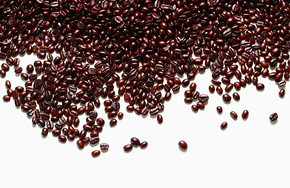What are the characteristics of Yemeni mocha
Follow the caf é (Wechat official account vdailycom) and found that Beautiful Cafe opened a small shop of its own.
The characteristics of mocha coffee
Yemenis have had the habit of drinking coffee since ancient times, and the coffee culture here is very different from that of other parts of the world. In Yemen, there are many middlemen engaged in the acquisition and storage of coffee, the newly purchased coffee is in no hurry to sell every year, and coffee farmers also hoard coffee at home as a means of saving. the ones that really enter the market are often old beans that have been in stock for several years. Due to the dry climate and lack of rain in Yemen, the water content of these coffee beans is very low, which gives Yemeni coffee a very unique taste.
In the coastal plain of the Red Sea in western Yemen, the climate and soil and water conditions are not suitable for growing coffee, and coffee is mainly produced in the western mountains. Mocha coffee grows in the mountains at an altitude of 3000 meters, where the geographical environment is unique, the mountain is rugged, the air is thin, the light is strong, and the water comes from rainfall and mountain springs, which make mocha coffee special aroma and taste. The local farmers carved out fertile terraces on the hillside. To this day, coffee is still grown in the same way in these areas as it was three or four hundred years ago, relying entirely on artificial labor, never using any chemical fertilizers or pesticides, and relying on sunshine, Rain Water and unique soil to grow pure natural Yemeni coffee. In fact, coffee grown in Haiti, Ethiopia and the West Indies belongs to the same ancestry as Yemeni coffee, and many of them are known as mocha coffee. However, for a variety of reasons, their taste and aroma are very different from those of mocha coffee produced in Yemen.

Yemeni coffee is also picked and processed entirely by hand. The preliminary processing of coffee beans is made by drying and drying naturally in the sun. This method is the most primitive and simple, without any machinery or cleaning, so sometimes there are a small amount of sand and pebbles in Yemeni coffee beans. At present, only Brazil, Haiti and a few parts of India still use drying method to treat coffee beans. The coffee roasting process is also done entirely by hand, and the heat depends entirely on experience and feeling. Every process from planting, picking to roasting is done in the oldest way, and although the roasted beans are of different colors, it is this aroma mixed with rugged and wild flavors that makes the unique Yemeni mocha coffee. No wonder some people call Mocha "the diamond in the crown of Asian coffee".
Yemeni coffee has different names according to its specific origin, and there are 13 main kinds of coffee. Although the taste and flavor are slightly different, it is still collectively called mocha. Among them, the most famous varieties, such as Sanani, Mattari and Harazi, are mainly distributed in the mountains around the capital Sana'an and the high-altitude mountains between Sana'an and Hodeida province. Yemeni mocha coffee has small fruit, high density, high acidity and unique aroma. Compared with other famous coffee varieties, it has a strong sour taste, as well as a mixture of malt, nuts, wine, chocolate and other spices.
The Yemeni mocha coffee has distinct taste characteristics, special taste and varied levels. It has a strong sour taste, a pleasant fruit acidity, and an obvious chocolate taste. The stronger the coffee is, the easier it is to taste the chocolate. Therefore, in order to better understand the unique taste of Yemeni mocha coffee, people now add hot chocolate to make fancy mocha coffee.
Important Notice :
前街咖啡 FrontStreet Coffee has moved to new addredd:
FrontStreet Coffee Address: 315,Donghua East Road,GuangZhou
Tel:020 38364473
- Prev

What are the types of mocha coffee in Yemen
Following Kaiping (Wechat official account vdailycom) found that the Beautiful Caf é opened a small shop of its own in the common Yemeni mokas, with Mokha Mattari being the most famous. Madali, produced in the province of Bani Matar (another word for Bany Mattar), is a coffee produced at high altitude and usually has a good aroma of red wine, dry fruit, thick and deep taste.
- Next

Introduction to the description of planting flavor of coffee bean varieties in Yunnan
Following Ka Pin (Wechat official account vdailycom) found that two classic premium coffee varieties, Typica and Bourbon, which are the main coffee varieties cultivated in Yunnan Province, have opened a small shop of their own. In 1991, Katimo Catimor series varieties were introduced from Kenya (more resistant to virus and higher yield). A variety of Arabian species (also known as small grain species)
Related
- Detailed explanation of Jadeite planting Land in Panamanian Jadeite Manor introduction to the grading system of Jadeite competitive bidding, Red bid, Green bid and Rose Summer
- Story of Coffee planting in Brenka region of Costa Rica Stonehenge Manor anaerobic heavy honey treatment of flavor mouth
- What's on the barrel of Blue Mountain Coffee beans?
- Can American coffee also pull flowers? How to use hot American style to pull out a good-looking pattern?
- Can you make a cold extract with coffee beans? What is the right proportion for cold-extracted coffee formula?
- Indonesian PWN Gold Mandrine Coffee Origin Features Flavor How to Chong? Mandolin coffee is American.
- A brief introduction to the flavor characteristics of Brazilian yellow bourbon coffee beans
- What is the effect of different water quality on the flavor of cold-extracted coffee? What kind of water is best for brewing coffee?
- Why do you think of Rose Summer whenever you mention Panamanian coffee?
- Introduction to the characteristics of authentic blue mountain coffee bean producing areas? What is the CIB Coffee Authority in Jamaica?

